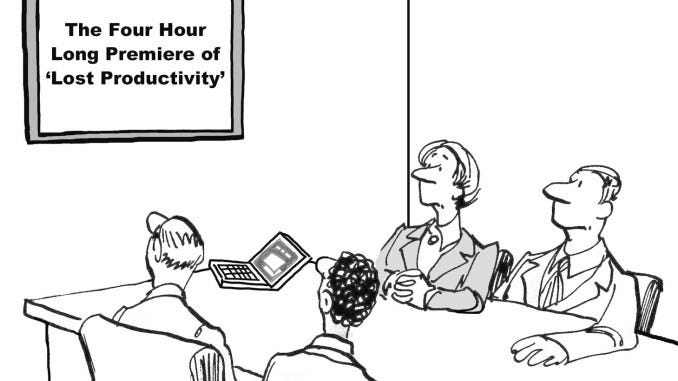The 3 Symptoms of Bad Productivity that No One is Talking About
(Are you doing any of them?)
(Are you doing any of them?)

If you’ve ever built a team, you’ve probably said and felt these three things:
1. I have so much work to do, I’ll hire more people.
But what inevitably happens with novice managers, is that after they hire more people, their work load increases. But how can that be!?
The whole reason we hired people was to reduce the workload!
But now, all of those new workers need work to do. And you’re responsible for their task list. So you end up dishing out assignments and finding more and more busy work for them.
This is called a management bottle-neck.
We’ll talk about it later.
Think about this for a second:
You’re not hiring because you’re growing. You’re hiring because you’re failing.
You either need more hands on deck, or you need a new skill on your team.
In either case, you’re hiring because your current team CAN’T execute. There’s a skill- or capacity-deficit.
Thinking of your business this way will force you to look honestly at what you need to do to improve the efficiency of your team before you start adding liabilities (ie. employees).
Hiring should be a last resort.
2. Our team is cranking hard everyday, but we still don’t seem to move the needle far enough.
This one is tricky. The problem is that most managers can’t tell the immediate difference between activity and productivity. Just because your team is moving and taking action doesn’t mean you’re all aligned to the same mission, and it doesn’t mean you’re not doing redundant work.
This is a communication problem is multi-faceted and can feel overwhelming, but it can be cleared up quickly — if you know how.
Often, this one comes from a misalignment.
This is when a few members of your team are not on the same page with the mission or vision of the project.
Let’s me be crystal clear:
This is NOT the same as agreement.
You’ll never get everyone in the room to agree with your way of doing things, but you CAN get them to align with the mission. This takes practice, but will pay a hefty ROI later on.
Example:
“Julie, I know you don’t agree we should ship the product this way, but can you align with the team and help us ship anyway? If we’re wrong, you can start the next project by saying ‘I was right.’”
3. I feel like I don’t know how to tell if my team is healthy or not.
You can ask them, but if you’re not a mind reader you’ll still be wondering about the truth when you’re done.
Plus, if you’ve ever asked a 6 year-old how their day was at school, you know the answer to this one.
“It was good.”
— Every 6 year-old, ever.
In order to get to the truth, not only must you be trustworthy, but your team must be ready and interested in trusting you. Combine that with good, truth-seeking questions and not “how was school?” and you’ll start to see honest, critical feedback.
Better example questions:
“If you could take any project off your plate right now, which would it be?”
“If you had a magic wand, on what would you wave it at work?”
“When was the last time you really felt valued by the team? What happened?”
Take a step back.
You’re a good manager!
You’re good with people!
You really care about your team!
And that might be enough to build a good product with which many customers are happy.
But if you want to build something amazing . . .
(something that really makes impact)
. . . you’re going to need to change your approach.
You’re going to need to:
Focus your team on what’s important.
That means testing what you should and shouldn’t be building, and being confident in your decision to move forward in a single direction at a time.
The reason most managers don’t do this, is because it’s absolutely terrifying.
I’ve sat on so many panels for early stage startups where founders jump up and down and say “our product is for everyone! Isn’t that great? And if we could only get .01% of this market . . . ”
Guess what?
Tom’s shoes aren’t for everyone.
And Ralph Lauren knows exactly who its target market is, and how they think.
Picking one direction and sticking to it actually sets off your brain’s limbic system (where your fight or flight response comes from).
It’s an ancient, once adaptive trait that’s telling you not to lose out on all the potential opportunities that exist. (Believe it or not, this is actually where FOMO comes from, too.)
But we all know what happens when we spread ourselves too thin; nothing.
Nothing gets done. Nothing is finished. Nothing is shipped.
You’re either building the most secure software, or the most easy-to-use software. It’s very, very rare to have both. Don’t try to compromise or you’ll get neither.
Pick one. Own it. And ask your team if they align with the mission.
Self-organized teams only operate successfully if they know how to make decisions based on the mission!
Pro-tip: Having a coach or a mentor who’s been through this experience is one of the most effective ways to survive it.
Cut out work-waste.
This means you’ll need to be communicating with your team without those 2 hour long, sit-down meetings that drag on and on about hypothetical implementations that only 1 or 2 people need to hear.
Stop checking email.
Stop responding to every notification.
Stop talking about implementation strategies and tactics when 3/5 people in the room don’t need to hear it. You’re literally burning dollars everytime you do this.
Think about it . . .
Let’s say you pay your developers $50/hr.
If you’ve got 5 of them, that’s $250 for every hour long meeting.
Unless you can track and measure whether or not your meetings are creating $251 of value, stop having hour long meetings!
Pro-Tip: Use 5 minute stand-up meetings where each team member answers three critical questions: 1) What did I do yesterday? 2) What will I do today? and 3) What are my impediments?
Reducing work waste also means you’ll need to empower your team to self-organize so you’re not a bottle-neck for tasks.
To be crystal-clear:
Empowering your team to self-organize does NOT mean throwing them all into the same pool of help-desk questions or the same list of features to build and saying “if everyone is working on this, they’ll work together and all of it will get done.”
This is the same failed logic that every school teacher has used when assigning a group task.
You know the ones I’m talking about, where one person does all the work, two people fuss around and produce a minor, non-risky/non-essential part of the project, and at least one person does literally nothing.
This is called “carrot or stick” management, and it usually just means people work just hard enough to get the carrot (a paycheck), and work just little enough to avoid the stick (getting fired).
Pro-Tip: For each task or project, make sure there is one, single, accountable person. There may be others that they’ll need to help them with the work, consult for advice, or to inform of a dependency, but a single point of failure will allow you to go right to the source, every time.
Get a “pulse-check” on your team.
Your team has vital signs, just like any other living organism.
Your team bleeds, sweats, and cries.
Most managers have no idea what these vital signs look like, and it can be a surprise when a key player leaves for another gig, or when your MVP stops producing at full-capacity.
Here’s the catch:
You need to have metrics and clear expectations in place before you start.
The MVP on your team might be noticing that you’ve been giving them more leeway on a project, so they’ve understood that to mean it’s become less important.
In fact, this scenario is LIKELY to happen, unless you’ve explicitly said something like “Great job on this. I’m going to back off and let you take it from here. Let me know if I can clear any roadblocks. I’m going to focus on the Steelman account, now.”
Unless you’ve stated what’s expected in clear, concise terms, you can’t expect your team to deliver.
Here’s an unclear request:
“You’re our sales guy. Go make more sales!”
Here’s a clear request:
“Success on this project would mean that we’ve made 20% more sales than this time last year, and that we have a list of critical feedback items to give to our developers at the end of each dev cycle.”
See the difference?
One is actionable, achievable, and measurable.
The other is just directional.
Pro-Tip: Signs that your team isn’t healthy or being productive: 1) lots of interruptions during work-time, 2) no one has questions or impediments to work through at team meetings, 3) progress reports sound vaguely like the 6 year-old’s day at school.
Signs that your team is healthy might be: 1) they’re taking action without asking permission for everything, 2) they’re all verbalizing that they’re “in alignment” with the goal of the project or sprint, and 3) they come to you when they hit a wall instead of everytime they hit an obstacle.
There’s SO much more to learn about managing teams, I can’t possibly write it in a 7 minute Medium post.
I work with startup founders and project directors and facilitate their team’s productivity and growth and I see these hangups all the time.
But it doesn’t have to be this way.
If you want more of this kind of thinking:
Go to my website 👉 HERE. 👈
Fill out the form at the bottom.
Start building a habit of productivity.
If you got something from this post, let me know in the comments.






